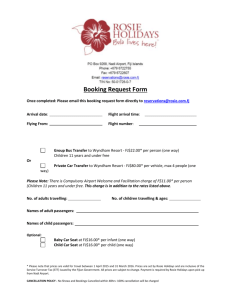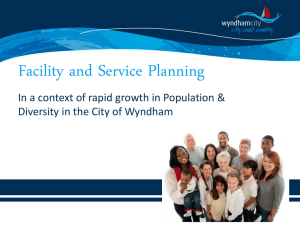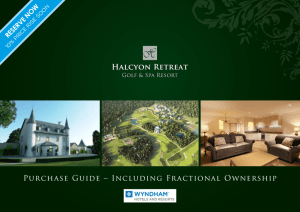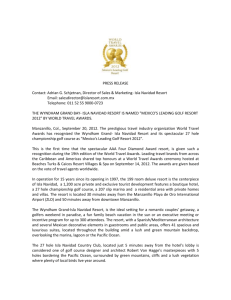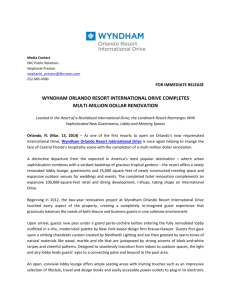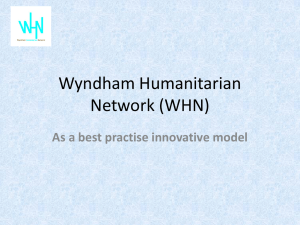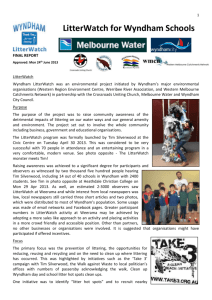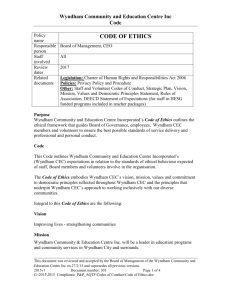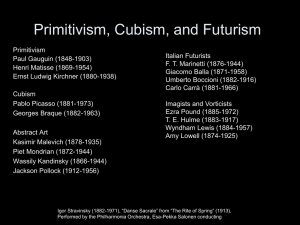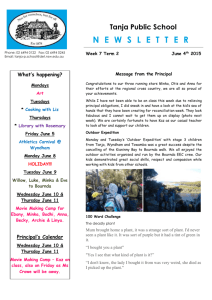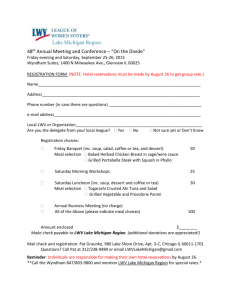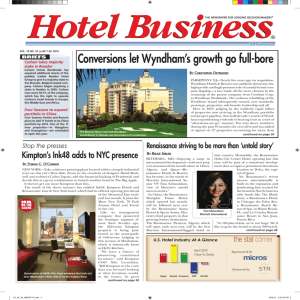21_mss04_wynd - Department of Transport, Planning and Local
advertisement
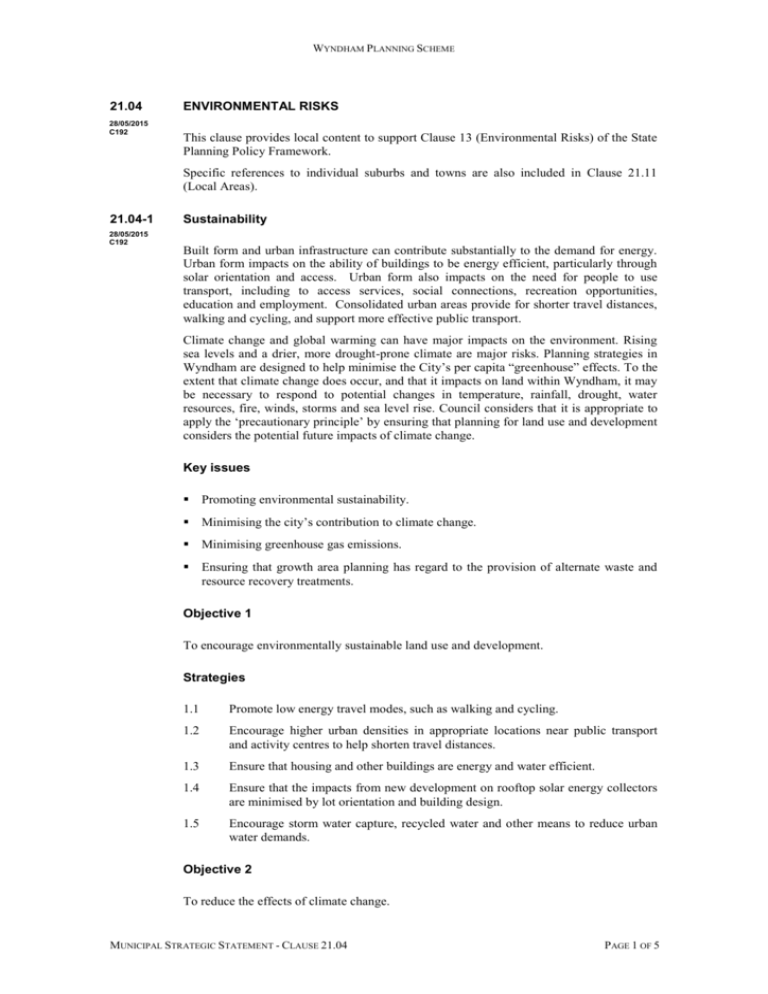
WYNDHAM PLANNING SCHEME 21.04 28/05/2015 --/--/20-C-C192 ENVIRONMENTAL RISKS This clause provides local content to support Clause 13 (Environmental Risks) of the State Planning Policy Framework. Specific references to individual suburbs and towns are also included in Clause 21.11 (Local Areas). 21.04-1 28/05/2015 C192 Sustainability Built form and urban infrastructure can contribute substantially to the demand for energy. Urban form impacts on the ability of buildings to be energy efficient, particularly through solar orientation and access. Urban form also impacts on the need for people to use transport, including to access services, social connections, recreation opportunities, education and employment. Consolidated urban areas provide for shorter travel distances, walking and cycling, and support more effective public transport. Climate change and global warming can have major impacts on the environment. Rising sea levels and a drier, more drought-prone climate are major risks. Planning strategies in Wyndham are designed to help minimise the City’s per capita “greenhouse” effects. To the extent that climate change does occur, and that it impacts on land within Wyndham, it may be necessary to respond to potential changes in temperature, rainfall, drought, water resources, fire, winds, storms and sea level rise. Council considers that it is appropriate to apply the ‘precautionary principle’ by ensuring that planning for land use and development considers the potential future impacts of climate change. Key issues Promoting environmental sustainability. Minimising the city’s contribution to climate change. Minimising greenhouse gas emissions. Ensuring that growth area planning has regard to the provision of alternate waste and resource recovery treatments. Objective 1 To encourage environmentally sustainable land use and development. Strategies 1.1 Promote low energy travel modes, such as walking and cycling. 1.2 Encourage higher urban densities in appropriate locations near public transport and activity centres to help shorten travel distances. 1.3 Ensure that housing and other buildings are energy and water efficient. 1.4 Ensure that the impacts from new development on rooftop solar energy collectors are minimised by lot orientation and building design. 1.5 Encourage storm water capture, recycled water and other means to reduce urban water demands. Objective 2 To reduce the effects of climate change. MUNICIPAL STRATEGIC STATEMENT - CLAUSE 21.04 PAGE 1 OF 5 WYNDHAM PLANNING SCHEME Strategies 2.1 Ensure that coastal planning considers and responds to the forecast impacts of climate change on sea levels. 2.2 Evaluate proposals with a view to limiting their potential greenhouse effects. Objective 3 To promote the use of water sensitive urban design (WSUD), including stormwater re-use. Strategies 21.04-2 28/05/2015 C192 3.1 Promote greater use of water harvesting and water reuse within residential areas. 3.2 Ensure all commercial, industrial and residential developments incorporate Water Sensitive Urban Design techniques particularly into their landscaped areas. 3.3 Incorporate best practice measures such as those contained in the Urban Stormwater Best Practice Environmental Management Guidelines, CSIRO 1999 into the design of all development. Waste Management The Wyndham Refuse Disposal Facility (Wyndham RDF) is identified within the Metropolitan Waste and Resource Recovery Strategic Plan: March 2009 as a regionally significant landfill site. It receives municipal, commercial and industrial waste (both solid inert and putrescible) from across Metropolitan Melbourne and the wider regional area. It is expected to continue for more than 60 years. Key issues Acknowledging that appropriately sited, designed and managed landfills play a critical role in protecting public health and the environment. Ensuring the long term security of well sited landfills such as the Refuse Disposal Facility from conflicting land uses. Objective 4 To provide for the ongoing and long term functional operation of the Wyndham RDF. Strategies 21.04-3 28/05/2015 C192 4.1 Ensure use and development of land around the Wyndham RDF is compatible with site operations. 4.2 Regulate the establishment and siting of amenity susceptible uses within proximity to Wyndham RDF. 4.3 Ensure that the adverse amenity impacts from Wyndham RDF are minimised. Floodplains The catchments of the various rivers and streams within Wyndham include areas of flood prone land where flooding has caused substantial damage to the natural and built environment. Floods are naturally occurring events and the inherent functions of the MUNICIPAL STRATEGIC STATEMENT - CLAUSE 21.04 PAGE 2 OF 5 WYNDHAM PLANNING SCHEME floodplains to convey and store floodwater are recognized. Floodplains need to be preserved to minimise the deterioration of environmental values and the long term flood risk to floodplain production, assets and communities. Key issues Protecting the community from the economic, social and environmental risks associated with flooding. Maintaining natural environmental processes within floodplains. Objective 5 To sustainably manage floodplains. Strategies 21.04-4 28/05/2015 C192 5.1 Discourage any urban expansion within floodplains that reduces flood storage, obstructs flood flows or increases the risk to life, health and safety. 5.2 Discourage raised earthworks that reduce natural flood storage, obstruct and/or redistribute flood flows, and increase flow velocities and levels. 5.3 Discourage developments in residential areas that encroach on 1:100 year floodplains or existing waterways. Bushfire Extensive areas of the municipality are prone to bushfires. Council has adopted the Wyndham Municipal Fire Management Plan (2013-2016) which has the primary objective of the protection of life and property. Areas of grassland in Wyndham have a history of large and fast moving fires which have the potential to cause loss of life and property. While fires in the open grasslands can be difficult to contain, the survival of crops, stock, plantations, homes and outbuildings can be enhanced through the implementation of appropriate fire protection programs. Key issues Identifying areas prone to bushfire. Applying design, siting and subdivision standards in bushfire prone areas. Objective 6 To minimise the risk to life, property and the environment from bushfire. Strategies 6.1 Ensure that the design, siting and layout of subdivision increase protection from fire. 6.2 Ensure that use and development include adequate fire protection measures. MUNICIPAL STRATEGIC STATEMENT - CLAUSE 21.04 PAGE 3 OF 5 WYNDHAM PLANNING SCHEME 21.04-5 28/05/2015 C192 Heat Island Effects Heat island effects are the product of high summer temperatures, lack of canopy or surface vegetation and heat absorbent surfaces to buildings and pavements. Together, they are a serious environmental health risk, especially in heat wave conditions. Key issues Identifying urban design as a factor in heat island impacts. Defining urban design responses to heat island impacts. Objective 7 To minimise the impacts of heat island through urban design responses. Strategies 21.04-6 28/05/2015 C192 7.1 Develop a range of design responses to heat island impacts. 7.2 Promote the introduction or retention of canopy trees and surface grasses especially in the public realm. 7.3 Minimise the extent of sealed surfaces. 7.4 Encourage the use of materials and finishes to buildings and pavements that minimise heat island effects. Implementation The strategies will be implemented through the planning scheme by: Application of zones and overlays The objectives, strategies and policy guidelines in the Planning Scheme are implemented through the application of appropriate zones and overlays. Apply the Environmental Significance Overlay to protect sites, areas and corridors of current and potential future environmental significance. Apply appropriate flooding overlays to areas identified by the Floodplain Manager (Melbourne Water) as subject to flooding Further strategic work Consider the application of the Bushfire Management Overlay to areas identified by the Municipal Fire Management Plan. Prepare strategic waterway management plans and waterway masterplans in line with the Wyndham Waterways Strategy Plan. Investigate the issues and opportunities for coastal planning in Werribee South. Expand the use of recycled water from the Western Treatment Plant for irrigation within the Werribee South Intensive Agriculture Precinct, for open space in industry, and for outdoor domestic use. MUNICIPAL STRATEGIC STATEMENT - CLAUSE 21.04 PAGE 4 OF 5 WYNDHAM PLANNING SCHEME Prepare and implement landscape and urban design guidelines to improve the quality of landscape and buildings in identified localities including around the Refuse Disposal Facility. Develop a Refuse Disposal Precinct Master Plan in consultation with the Wests Road RDF and Waste Management Community Reference Group. Consider the application of an Environmental Significance Overlay to protect existing landfill operations around the RDF as an outcome of the Precinct Master Plan process. Reference documents Municipal Fire Management Plan 2013-2016. Wyndham City Environment and Sustainability Strategy 2011-2015. MUNICIPAL STRATEGIC STATEMENT - CLAUSE 21.04 PAGE 5 OF 5
